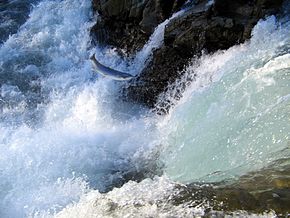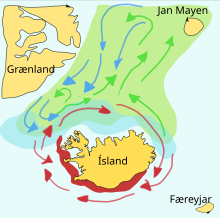
A | B | C | D | E | F | G | H | CH | I | J | K | L | M | N | O | P | Q | R | S | T | U | V | W | X | Y | Z | 0 | 1 | 2 | 3 | 4 | 5 | 6 | 7 | 8 | 9

Fish migration is mass relocation by fish from one area or body of water to another. Many types of fish migrate on a regular basis, on time scales ranging from daily to annually or longer, and over distances ranging from a few metres to thousands of kilometres. Such migrations are usually done for better feeding or to reproduce, but in other cases the reasons are unclear.
Fish migrations involve movements of schools of fish on a scale and duration larger than those arising during normal daily activities.[1] Some particular types of migration are anadromous, in which adult fish live in the sea and migrate into fresh water to spawn; and catadromous, in which adult fish live in fresh water and migrate into salt water to spawn.[2]
Marine forage fish often make large migrations between their spawning, feeding and nursery grounds. Movements are associated with ocean currents and with the availability of food in different areas at different times of year. The migratory movements may partly be linked to the fact that the fish cannot identify their own offspring and moving in this way prevents cannibalism. Some species have been described by the United Nations Convention on the Law of the Sea as highly migratory species. These are large pelagic fish that move in and out of the exclusive economic zones of different nations, and these are covered differently in the treaty from other fish.
Salmon and striped bass are well-known anadromous fish, and freshwater eels are catadromous fish that make large migrations. The bull shark is a euryhaline species that moves at will from fresh to salt water, and many marine fish make a diel vertical migration, rising to the surface to feed at night and sinking to lower layers of the ocean by day. Some fish such as tuna move to the north and south at different times of year following temperature gradients. The patterns of migration are of great interest to the fishing industry. Movements of fish in fresh water also occur; often the fish swim upriver to spawn, and these traditional movements are increasingly being disrupted by the building of dams.[3]
Classification

As with various other aspects of fish life, zoologists have developed empirical classifications for fish migrations.[5] The first two following terms have been in long-standing wide usage while others are of more recent coinage.
- Anadromous – fish that migrate from the sea up (Greek: ἀνά aná, "up" and δρόμος drómos, "course") into fresh water to spawn, such as salmon, striped bass,[6] and the sea lamprey[7]
- Catadromous – fish that migrate from fresh water down (Greek: κατά kata, "down" and δρόμος dromos, "course") into the sea to spawn, such as eels[6][8]
George S. Myers coined the following terms in a 1949 journal article.
- Diadromous – all fish that migrate between the sea and fresh water. Like the two aforementioned, well-known terms, diadromous was formed from Classical Greek (, "through"; and , "running").
- Amphidromous – fish that migrate from fresh water to the sea, or vice versa, but not for the purpose of breeding. Instead they enter saltwater or freshwater as larvae, where they will grow into juveniles before returning to the habitat they originally came from and stay there for the rest of their life, growing into sexually mature adults.[9]
- Potamodromous – fish whose migrations occur wholly within fresh water
- Oceanodromous – fish that live and migrate wholly in the sea[5][10]
Although these classifications were originated for fish, they are, in principle, applicable to any aquatic organism.
List of diadromous orders and families, and the number of known species:[9][11]
Forage fish

Forage fish often make great migrations between their spawning, feeding and nursery grounds. Schools of a particular stock usually travel in a triangle between these grounds. For example, one stock of herrings have their spawning ground in southern Norway, their feeding ground in Iceland and their nursery ground in northern Norway. Wide triangular journeys such as these may be important because forage fish, when feeding, cannot distinguish their own offspring.[3]
Capelin are a forage fish of the smelt family found in the Atlantic and Arctic oceans. In summer, they graze on dense swarms of plankton at the edge of the ice shelf. Larger capelin also eat krill and other crustaceans. The capelin move inshore in large schools to spawn and migrate in spring and summer to feed in plankton rich areas between Iceland, Greenland and Jan Mayen. The migration is affected by ocean currents. Around Iceland maturing capelin make large northward feeding migrations in spring and summer. The return migration takes place in September to November. The spawning migration starts north of Iceland in December or January.[12]
The diagram on the right shows the main spawning grounds and larval drift routes. Capelin on the way to feeding grounds is coloured green, capelin on the way back is blue, and the breeding grounds are red.
In a paper published in 2009, researchers from Iceland recount their application of an interacting particle model to the capelin stock around Iceland, successfully predicting the spawning migration route for 2008.[13]
Highly migratory species

The term highly migratory species (HMS) has its origins in Article 64 of the United Nations Convention on the Law of the Sea (UNCLOS). The Convention does not provide an operational definition of the term, but in an annex (UNCLOS Annex 1) lists the species considered highly migratory by parties to the convention.[14] The list includes: tuna and tuna-like species (albacore, bluefin, bigeye tuna, skipjack, yellowfin, blackfin, little tunny, southern bluefin and bullet), wahoo, pomfret, marlin, sailfish, swordfish, saury and oceangoing sharks, dolphins and other cetaceans.
These high trophic level oceanodromous species undertake migrations of significant but variable distances across oceans for feeding, often on forage fish, or reproduction, and also have wide geographic distributions. Thus, these species are found both inside the 200-nautical-mile (370-kilometre) exclusive economic zones and in the high seas outside these zones. They are pelagic species, which means they mostly live in the open ocean and do not live near the sea floor, although they may spend part of their life cycle in nearshore waters.[15]
Highly migratory species can be compared with straddling stock and transboundary stock. Straddling stock range both within an EEZ as well as in the high seas. Transboundary stock range in the EEZs of at least two countries. A stock can be both transboundary and straddling.[16]
It can be challenging to determine the population structure of highly migratory species using physical tagging. Traditional genetic markers such as short-range PCR products, microsatellites and SNP-arrays have struggled to identify population structure and distinguish fish stocks from separate ocean basins. However, population genomic research using RAD sequencing in yellowfin tuna,[17][18] albacore,[19][20] and wahoo[21] has been able to distinguish populations from different ocean basins and reveal fine-scale population structure. Similar population genomics methods have also provided improved insight towards population structure in striped marlin.[22]
Other examples
Some of the best-known anadromous fishes are the Pacific salmon species, such as Chinook (king), coho (silver), chum (dog), pink (humpback) and sockeye (red) salmon. These salmon hatch in small freshwater streams. From there they migrate to the sea to mature, living there for two to six years. When mature, the salmon return to the same streams where they were hatched to spawn. Salmon are capable of going hundreds of kilometers upriver, and humans must install fish ladders in dams to enable the salmon to get past. Other examples of anadromous fishes are sea trout, three-spined stickleback, sea lamprey and [7] shad.
Several Pacific salmon (Chinook, coho and Steelhead) have been introduced into the US Great Lakes, and have become potamodromous, migrating between their natal waters to feeding grounds entirely within fresh water.
Zdroj:https://en.wikipedia.org?pojem=Fish_migration
Text je dostupný za podmienok Creative Commons Attribution/Share-Alike License 3.0 Unported; prípadne za ďalších podmienok. Podrobnejšie informácie nájdete na stránke Podmienky použitia.
Antropológia
Aplikované vedy
Bibliometria
Dejiny vedy
Encyklopédie
Filozofia vedy
Forenzné vedy
Humanitné vedy
Knižničná veda
Kryogenika
Kryptológia
Kulturológia
Literárna veda
Medzidisciplinárne oblasti
Metódy kvantitatívnej analýzy
Metavedy
Metodika
Text je dostupný za podmienok Creative
Commons Attribution/Share-Alike License 3.0 Unported; prípadne za ďalších
podmienok.
Podrobnejšie informácie nájdete na stránke Podmienky
použitia.
www.astronomia.sk | www.biologia.sk | www.botanika.sk | www.dejiny.sk | www.economy.sk | www.elektrotechnika.sk | www.estetika.sk | www.farmakologia.sk | www.filozofia.sk | Fyzika | www.futurologia.sk | www.genetika.sk | www.chemia.sk | www.lingvistika.sk | www.politologia.sk | www.psychologia.sk | www.sexuologia.sk | www.sociologia.sk | www.veda.sk I www.zoologia.sk
